July 21, 2021
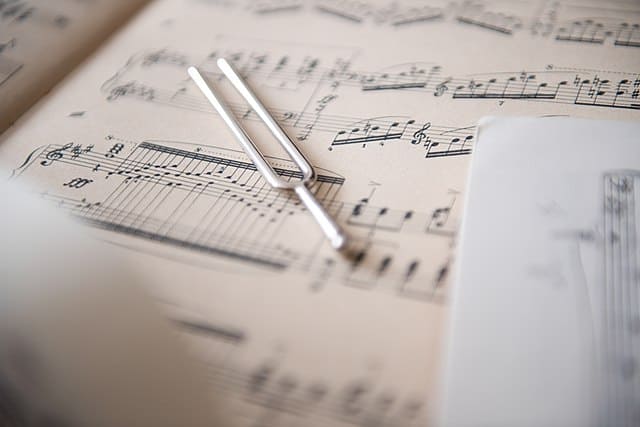
By Nicolette Foss
Tuning by ear comes only with years of experience (*ahem* Chris), or through the rare inherent ability of those freaks-of-nature with perfect pitch. And we say to those freaks, hey this article is not for you! For the rest of us who get by with a little help from our device friends, stay tuned, this article is for you.
But is a tuning app right for your tuning needs? In this article, we will discuss the advantages and disadvantages of different kinds of tuners. We will also introduce our top picks for hammered dulcimer tuning apps.
Electronic Tuners vs Hammered Dulcimer Tuning Apps
Chromatic electronic tuners have been the go-to for years when it comes to tuning the hammered dulcimer (note: you need a chromatic tuner even if your dulcimer is not a chromatic). But just like any other technology, it is now easily replaceable with more convenient alternatives. Today, those alternatives are tuning apps you can download on your smartphone.
To decide whether or not you want to go the app route, it is useful to weigh the advantages and disadvantages of electronic tuners.
Advantages of electronic tuners:
- Accuracy
- Pretty simple to use and understand.
- Less sensitive: You can easily use them in a group setting with a lot of ambient noise.
Disadvantages of electronic tuners:
- Battery-operated: Depending on the electronic tuner you choose, your battery life can run out quickly.
- Clip-on tuners have a hard time staying on. Since they are typically used for instruments like guitars, they are not meant to mold
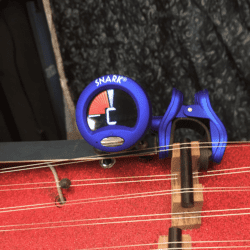
This is how we clip our Snark SN1X electronic tuner to easily pick up the notes from our hammered dulcimer without having to move it around!
ergonomically to the dulcimer. And since there aren’t a lot of places to stash your tuner, sometimes this can be a problem.
- Pricier: Quality electronic tuners can range anywhere from $12 to $80.
- Easy to forget to bring along with you (it happens to the best of us!).
Our electronic tuner recommendations:
We have been using Snark SN1X electronic tuners for years, and we love them. Although it is a clip-on tuner, it has a gooseneck feature that allows it to twist so you can see it at whatever angle. If you want one, we’ll be able to add it to your purchase or you can buy one directly from Sweetwater for $11.99, plus shipping and taxes.
To combat the frustration of constantly moving your tuner around, we simply clip our Snark SN1X to the top of the bridge, under the strings. You won’t have to move it, and it should be able to pick up any notes you hit.
Another option is Dusty Strings’ electronic Dulci-Tuner that easily sits on your tuning pins. Though it may be a little pricey at $79, we believe it might be worth it if you are a hardcore dulcimer fanatic who gets a lot of mileage out of your instrument.
3 of Our Top Picks For Hammered Dulcimer Tuning Apps
Electronic turners are simple enough, right? But, as with any progression of technology, a more convenient and cheaper alternative method has emerged.
Having a dulcimer tuning tool on your smartphone can be extremely convenient since our phones are basically attached to our hips at all times. Who isn’t a little (or A LOT) addicted to their phone? This means you are much less likely to forget it than an electronic tuner, and it will be there when you need it.
There are lots of tuner apps available for your smartphone, and we tried a few of ‘em out. Here are our favorites:
#1. Pano Tuner
Cost: Free
Available for: iOS (Apple’s App Store) or Android (Google Play).
Coming in at our number 1 spot is Pano Tuner. Many hammered dulcimer players like and use this app. We have found this app is easy to use, very accurate (maybe more so than an electronic tuner), and doesn’t have a lot of the unnecessary bells and whistles other apps may have. Since we just want to tune our dulcimer, this is ideal!
This app does contain ads, but they are non-intrusive. Some users do complain that the app will pick up talking or other sounds, but you should be able to figure out what tone is yours. We highly recommend this app for when you are playing alone or with a buddy or two.
Here is the interface of Pano Tuner:
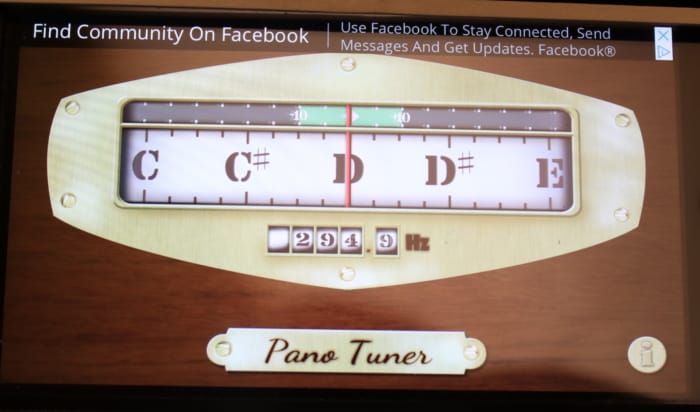
Click the little ‘i’ in the lower right and it turns over for the settings menu. You’ll notice we set it for A 442 which is perfect for hammered dulcimers. They sound better just a little sharp than they do a little flat.
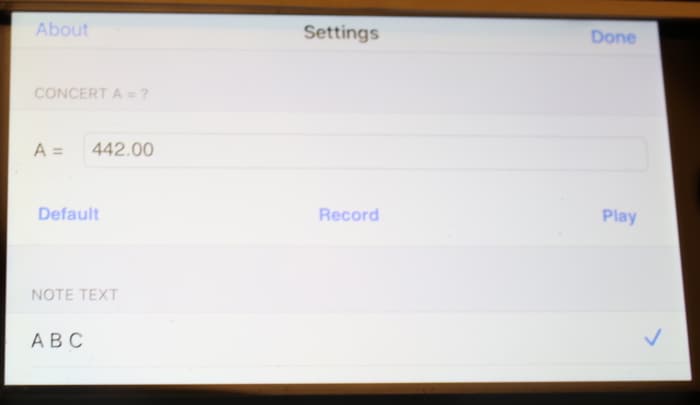
#2. Cleartune
Cost: $3.99
Available for: iOS (Apple’s App Store)
Cleartune has more functions and settings than Pano Tuner; however, we are not so sure these are very useful for the hammered dulcimer. But it’s still fun to play with! This app includes a lot of arcane intonations, and we believe it may be more accurate than a separate electronic tuner.
Here is the interface for Cleartune:
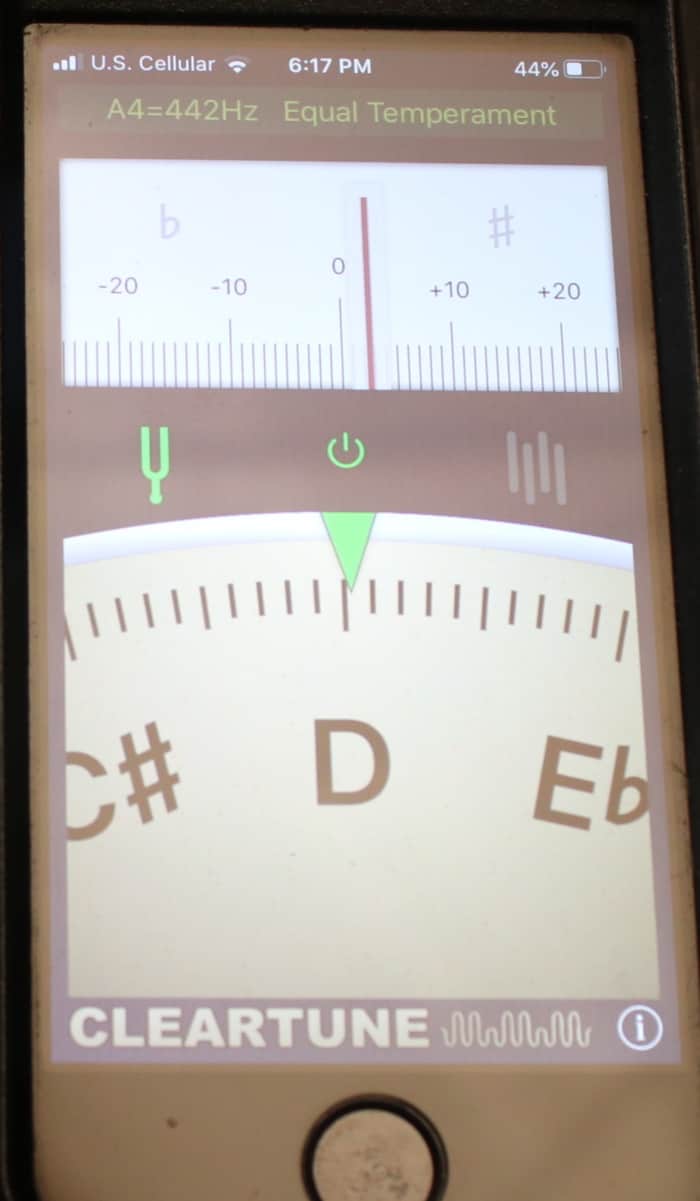
#3. Tuner T1
Cost: Free
Available for: iOS (Apple’s App Store) or Android (Google Play)
This simple chromatic tuner app gives you a full-screen display and a clear indication of when the right chord is matched. Additionally, it can work as a pitch pipe Tone Generator, by playing any music note that you can use as a reference for tuning. Tuner T1 does contain ads and offers in-app purchases.
Here is an example of Tuner T1’s interface:
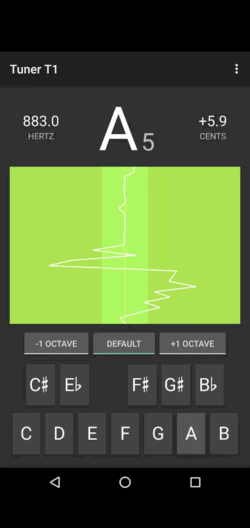
Tips for Using Your Phone to Tune Your Hammered Dulcimer
Now that you’ve got the rundown on our top picks, determine which is the right one for you.
Simply download the chosen app, then lay your phone right on the dulcimer strings. This is the best way to combat sound interference so you can get a nice clear sound from your hammered dulcimer.
If you chose Pano Tuner as your tuner app: Once you land in the green diamond, you have reached the desired note.
Pro-tip: If your dulcimer is on the stand and tilted, wrap a rubber band around the phone and then lay it on the strings. The rubber band will keep the phone from sliding off.
Tuning a hammered dulcimer requires a device (electronic tuner or tuning app), a tuning wrench, and a tuning chart. Pick out the right tuning diagram here if you have lost yours and you are playing a Songbird Hammered Dulcimer. Use it as a tuning guide to refer to as you tune. New to dulcimer tuning? You can also find out how to tune a hammered dulcimer by watching the tuning videos on the same page.
Now that you’ve got your tuning chart, tuning wrench, and tuning app, you’re good to go!
Big Pro-tip: Someone alerted us that tuner pickup clips exist for cell phones, so I checked and found the Peterson Pitch Grabber at http://www.sweetwater.com for $14.99. It is an active pickup which when plugged in to the phone bypasses the onboard mic, thus isolating from ambient noise. It has a 3.5mm jack which plugs right in to an Android device. When used with a Lightning to 3.5mm adapter it also works with any iPhone. I found the adapter (which I will need when I get the Pitch Grabber) at Wal-Mart for $7.99. The Pitch Grabber is a nice device, works with any app, needs no battery, and gets great reviews. Definitely going to get one myself. Chris Foss 7/26/2021
To App or Not to App, That is the Question
With the rise of electronic tuners, tuning forks became a thing of the past. So have electronic tuners become obsolete with the rise of smartphone apps? Absolutely not! Although these apps we have mentioned are convenient and cheap, their extreme sensitivity may not be ideal for jamming in a group setting. And the delicacy of your phone and finding the right position to tune might also cause some tuning problems.
What do you think? Do you prefer a good ol’ electronic tuner or are you trail-blazing into the modern age of tuning apps with no looking back? Let us know in the comments below!
Featured image: Lukasz Kobus, European Commission, Attribution, via Wikimedia Commons
 About the author: In her childhood, Nicolette Foss could be found underneath piles of sawdust in her father’s hammered dulcimer workshop. She helped with odds and ends in the business, attended folk music festivals, and learned the importance of hard work. These days, you can find her belly dancing to instrumental Arabic music, learning the Serbian language, making short films with friends, and cuddling her cat Georgie. If you’d like to hire Nicolette for content writing or copywriting work, contact her at: nicolettelady@protonmail.com
About the author: In her childhood, Nicolette Foss could be found underneath piles of sawdust in her father’s hammered dulcimer workshop. She helped with odds and ends in the business, attended folk music festivals, and learned the importance of hard work. These days, you can find her belly dancing to instrumental Arabic music, learning the Serbian language, making short films with friends, and cuddling her cat Georgie. If you’d like to hire Nicolette for content writing or copywriting work, contact her at: nicolettelady@protonmail.com
4 Comments
-
You can add a clip-on cable to a smart phone rather than using the phone’s microphone. I clipped the pickup on the hand-hole on the bottom, and it worked great until I went to a festival and tuned in a room with 29 other instruments. The readout went crazy. My HD was acting like a huge microphone. Moving the clip to a hitch pin solved the problem. If you think of it, try it; if it works, do it.
-
Where do you find this type of attachment? Most music / Instrument stores I know of do not carry them.
-
